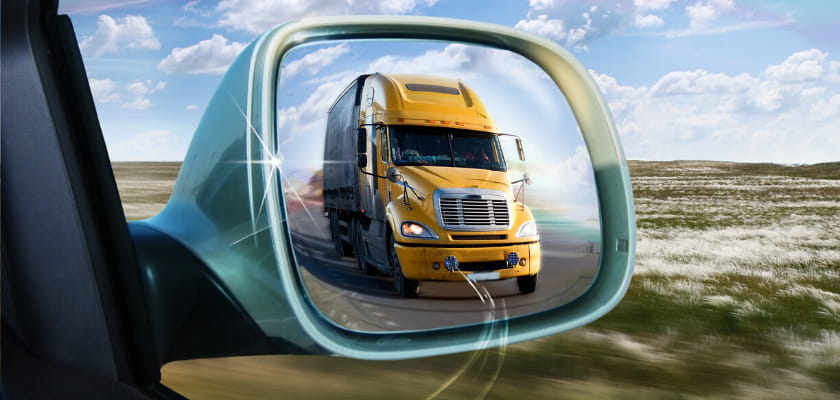Reflections on Using Mirrors When Driving

Mirror use is behind 7 percent of near-collisions. We explore why—and what safety managers can do about it.
It’s one of the easiest habits a driver can master to improve road safety—using mirrors when driving. After all, it’s just a glance in the mirror, right? Yet according to a sampling of Lytx data of 5 billion miles driven, inadequate mirror use is behind 7 percent of near-collisions.
The Federal Motor Carrier Safety Administration (FMCSA) reports that 14 percent of large truck collisions occurred as a result of drivers’ inadequate surveillance, including lane changes and turns where drivers looked in the proper direction but still failed to see approaching traffic. (For examples of inadequate mirror use, check out this video, or this one.)
Lytx Director of Risk and Compliance Gary Johnson, a 30-year veteran of the fleet safety industry, isn’t surprised by these statistics. In fact, he believes problems with mirror use are rising—and that’s consistent with the FMCSA’s findings. So what gives? Why is lack of mirror use so prevalent in commercial driving? And what can fleet safety managers do about it? Here’s Johnson’s take on it all.
The root of the problem
Adjusting and checking mirrors properly, though it seems simple, often takes a back seat to other safety priorities. “Checking mirrors seems not to be on the radar with safety managers as much as close following and distracted driving are,” Johnson said. “But drivers are setting themselves up for blind spots when they don’t adjust their mirrors or check them often enough, and it increases their risk of collision.”
Also, an increasing reliance on in-cab technology might cause employees to believe that mirrors somehow will adjust themselves. With forward collision mitigation and GPS fleet tracking becoming more common in commercial vehicles, drivers may be becoming increasingly reliant on these technologies as they wait for it “to kick in,” Johnson said.
“There seems to be a false sense of security, a belief that mirror placement will take care of itself,” he said. “As in-cab safety technologies continue to advance, I worry that mirror use among commercial drivers will worsen over time.”
So how can fleet safety managers encourage using mirrors while driving? Johnson offered these five bits of advice:
1. Make mirror use a key part of driver orientation and training.
Some fleets set up mirror stations at their orientations, and it’s a great idea, Johnson said. Ensuring that drivers know how to switch lanes and aim mirrors early in their training can make a big difference in their mastery of mirror placement throughout their driving careers. A properly aimed mirror can help reduce blind spots and increase visibility. And making mirror use a topic in monthly safety meetings and email communications can keep it fresh in drivers’ minds.
2. Encourage drivers to maintain a constant glance at all their mirrors while they’re driving.
Johnson recommends drivers glance at each of their mirrors every 8 to 10 seconds. “It’s a glance, not a stare,” he said. At 60 miles per hour, drivers travel nearly 100 feet per second down the road. “By fixating on a mirror, you’re traveling that distance essentially blind,” Johnson said. “That’s why it’s key to glance.” By checking mirrors during pre-trip inspections, drivers can reduce blind spots on their routes as well.
3. Use video technology to coach drivers on properly scanning mirrors.
When employees need a refresher on proper mirror use, safety managers can review video event clips with them so they can see their actions and learn how to improve. “Drivers care as much as anyone,” Johnson said. “Those who aren’t scanning their mirrors frequently certainly aren’t doing it intentionally. So, simply mentioning it can go a long way.”
4. Point out the no-zone.
As the FMCSA states, commercial trucks are surrounded by a “no-zone,” an area around a commercial vehicle where collisions are most likely to occur. According to the association, one-third of all collisions between large trucks and cars take place in no-zones, where blind spots are plentiful.
“That’s why it’s so important for commercial drivers to check not only their mirrors, but also their blind spots before changing lanes,” Johnson said. “Car drivers, too, need to understand the extent of a commercial truck’s blind spots and do their best to stay clear of them.”
5. Discuss with drivers the importance of looking far enough ahead.
The FMCSA recommends that drivers look at least 15 seconds down the road (that’s about one-quarter of a mile on the interstate and about 1.5 blocks in the city). Looking ahead can help drivers respond to approaching conditions and avoid hard braking events, the association stated.
You can find additional helpful content on driver safety in the Lytx Resource Hub.
